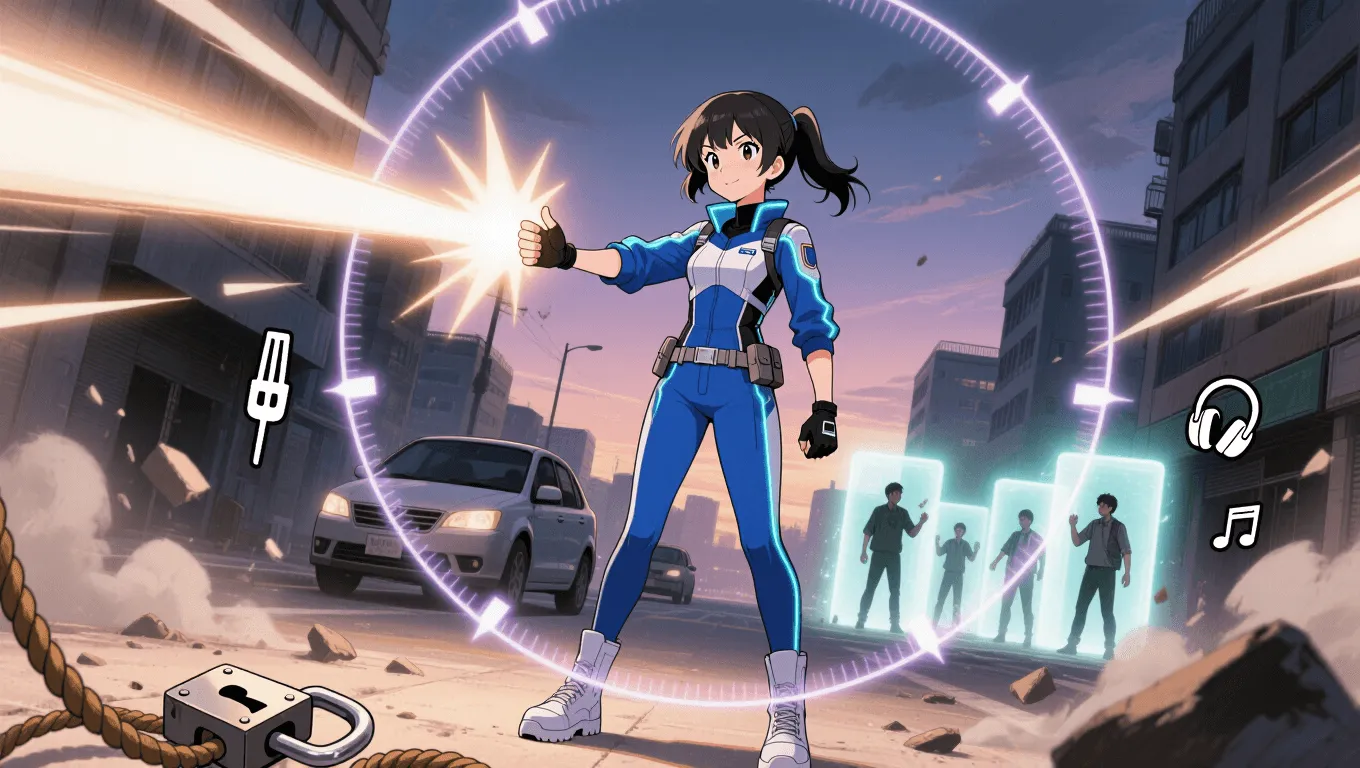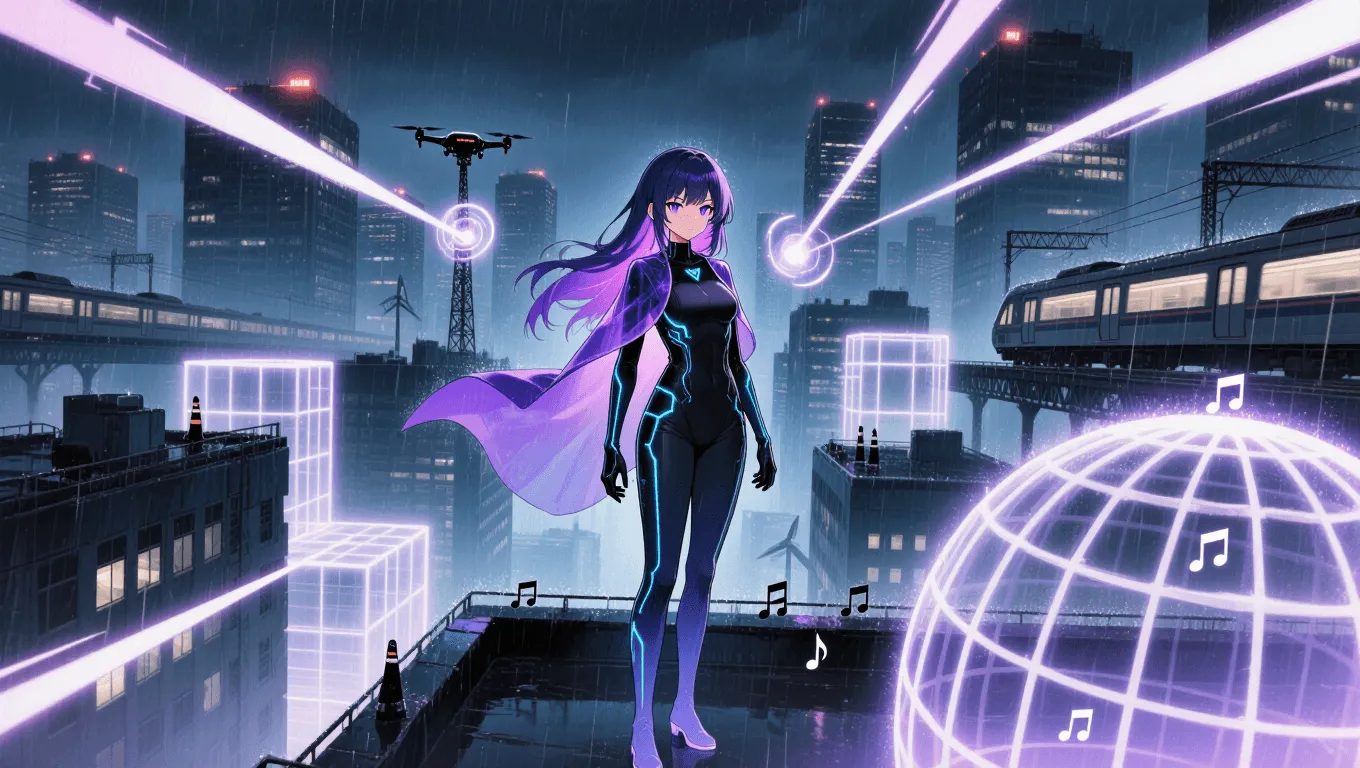Radiant Rhapsody

Radiant Rhapsody Video Demo 🎬
Table of Contents
Radiant Rhapsody is a hybrid energy superpower that converts sound into precise, controllable light. By translating vibration into photons, a user can project blinding flares, carve clean beams, weave hard-light shields, and paint the battlefield with prismatic control. Because Radiant Rhapsody scales with audio input and harmonic technique, it rewards rhythm, timing, and creative sound design. This guide breaks down how the power works, what it does best, where it struggles, and how to level it up—plus synergies, counters, and notable inspirations from comics and games. For more powers, browse the Superpower Wiki or spin the Random Superpower Generator.
What Is Radiant Rhapsody
Radiant Rhapsody is sonic lightcraft: the user absorbs, generates, or channels sound (voice, instruments, environmental noise) and transduces it into photonic output. The “rhapsody” aspect refers to using melody, tempo, and dynamics as control inputs—strong beats yield pulses, smooth legato yields steady beams, and layered harmonies enable multi-spectral effects. Practitioners often develop a signature “sound palette” (voice, violin, sub-bass drum, etc.) that shapes their color spectrum and light behavior.
Under the hood, the power hinges on resonance and phase. Frequencies map to wavelengths: lower tones bias toward wide, soft illumination; midrange shapes coherent constructs; treble spikes tend to become piercing lances or strobing bursts. With training, users learn to phase-lock different bands, creating stable shields or complex tools.
Core Abilities of Radiant Rhapsody
Sound-to-Light Transduction
At its simplest, the user transforms audible (and near-ultrasonic/subsonic) energy into photons. Louder or more precisely controlled sound equals stronger light. Whisper-level input still works, but output is small and short-lived unless amplified internally.
Harmonic Light Projection
Users sculpt beams, cones, and arcs of light by modulating pitch and amplitude. A sustained note produces a steady ray; tremolo yields a pulsing “sawtooth” beam useful for sawing through restraints; vibrato introduces micro-lens effects that can deflect or widen the beam.
Resonant Shielding
Layered chords can knit a translucent, hex-cell barrier—“harmonic shielding”—that disperses kinetic force and dazzles on impact. Shields are strongest at chord resolution (when overtones lock), so chord progressions become literal defensive sequences.
Photonic Constructs and Tools
With clean harmonics, the user extrudes temporary hard-light shapes: blades, platforms, manacles, lattice bridges, and prisms. Constructs persist while the sustaining tone remains coherent; any pitch drift or breath break can cause collapse.
Sensory & Utility
Radiant Rhapsody grants low-light vision and the ability to flood areas with glare-free illumination. Subtle echolight pings (quiet chirps translated to micro-flashes) map rooms, detect motion, and outline hidden seams—an elegant blend of echolocation and lidar.
Crowd Influence & Nonlethal Control
Soft, warm hues coupled with slow rhythms soothe and steady heart rates; sudden staccato pulses induce startle, disorientation, or voluntary compliance. This makes the power excellent for de-escalation, riot control, and extraction without lasting harm.
Restorative Glimmer (Minor)
Carefully tuned biophotonic warmth can accelerate superficial healing—closing small cuts, reducing bruising, or easing migraines—by nudging cellular processes. It is supportive, not surgical, and burns energy quickly.
Environmental Interaction
Light output can scramble basic optical sensors, wash out cameras, and create EM noise in the visible spectrum. In fog, smoke, or dust, scattered light outlines silhouettes but reduces beam coherence—both a boon (recon) and a bane (weaker attacks).
Application / Tactical Advantages in Combat
Range & Zoning
Radiant Rhapsody excels at mid-range space control. Conical flares deny sight lines; rim-light outlines expose cloaked targets; prismatic walls shepherd opponents into safe lanes. A user can “paint” zones safe for allies and hostile for enemies.
Stealth & Counter-Stealth
Micro-pulses read rooms like sonar without revealing position if kept sub-luminal and masked by ambient noise. Against invisibility or illusion, angle-swept beams produce reflective cues that betray outlines and depth mismatches.
Nonlethal Takedown
Strobe-scaled to 7–15 Hz induces disorientation without permanent harm. A brief “whiteout” flash paired with photonic cuffs ends fights fast while preserving bystanders and evidence.
Anti-Projectile Defense
Harmonic shields can deflect or vaporize low-mass projectiles. Against firearms, rapid “shutter” panels reduce visibility and mess with aim; against thrown blades, a tight, slanted pane sheds momentum sideways.
Team Utility
Radiant Rhapsody is a natural support: battlefield lighting, signaling, synchronized tempo for coordinated pushes, and quick blind screens to reset engagements.
Level: Power Growth & Mastery
Level 1 🏙️

Profile: Street-level rescuer and crowd-controller.
Capabilities:
-
Hand-bright illumination, camera-wash flashes, and soft-shell shields that block debris.
-
Short-range beams for cutting ropes or melting locks.
-
Basic echolight mapping within 10–15 meters.
Training Focus: Breath control, metronome timing, ear protection, and safe strobe rates.
Common Pitfalls: Overflashing allies, tunnel vision in bright fields, and vocal strain.
Level 2 🌇

Profile: City-scale defender with tactical constructs.
Capabilities:
-
Stable hard-light panels and prisms; mobile platforms for short hops.
-
Multi-band output: beam + flare + rim-light simultaneously.
-
Advanced counter-stealth sweeps and anti-drone glare nets.
Training Focus: Chord progressions for shield stability, in-motion phrasing, sound sourcing (portable speakers or loopers).
Common Pitfalls: Overdraw (photonic fatigue), losing coherence in crosswinds, scattering in smoke.
Level 3 🌃

Profile: Night-dominating virtuoso.
Capabilities:
-
City-block blackout denial: precise curtain walls and safe corridors.
-
Multi-construct choreography: cages, ramps, and kinetic-diffusing domes.
-
Surgical beam shaping for precision disablement of optics and sensors.
Training Focus: Full-body resonance (bone-conducted feedback), silent “internal” tone loops, and environmental harmonization (using trains, sirens, turbines as fuel).
Common Pitfalls: Heat buildup, dehydration, and collateral reflection from glass high-rises.
Limitations of Using the Radiant Rhapsody
-
Sound Dependency: Output scales with sound availability. In vacuum, deep silence fields, or anechoic chambers, Radiant Rhapsody drops to whisper-level utility unless the user can self-generate robust audio.
-
Line-of-Sight: Photonic effects demand clear paths. Corners, mirrors, and dense cover degrade or redirect beams. Over-reliance on direct light can be exploited by opponents who fight from shadow or behind polarizing filters.
-
Scattering & Absorption: Fog, smoke, heavy rain, and particulate-rich air scatter light, reducing penetration. Black, matte, or meta-materials can absorb or dampen output.
-
Energy & Physiology: Extended use causes photonic fatigue—eye strain, migraines, hoarseness, tinnitus, and heat stress. Hydration, rest, and hearing protection are mandatory.
-
Coherence Stability: Hard-light constructs collapse if the sustaining tone wobbles. Emotional stress and uneven breathing introduce phase jitter that weakens shields and tools.
-
Friendly Fire Risk: Strobes can disorient allies and trigger photosensitive responses if the user lacks discipline and team protocols.
Weakness Against What Other Superpowers
-
Silence/Null Fields: Sound-dampening auras, vibration nullifiers, and vacuum generation deprive Radiant Rhapsody of its primary fuel source.
-
Shadow & Light Absorption: Darkness manipulation, blackbody fields, or photonic sponges drink in output, turning brilliant attacks into dim embers.
-
Refraction/Reflection Control: Mirror mages and refraction controllers can bend or send beams back—forcing caution with direct lances.
-
Vibration Scramble: Harmonic jammers and chaos noise inject phase noise, destabilizing shields and constructs.
-
Electromagnetic Interference: EM storms or magneto-kinetic disturbances can fuzz fine light structures, especially near sensitive tech.
-
Gravity Distortion: Gravitokinetics lens and curve beams, spoiling aim and diluting intensity at the target.
-
Intangibility/Phase Shift: Phasers ignore hard-light confinement by slipping out of the photonic lattice.
-
Illusion & Glamour: High-tier glamours trick the user’s visual feedback, causing misread geometry during rapid maneuvers.
Synergistic Power Combos
-
Perfect Pitch / Vocal Mastery: Clean intonation equals cleaner constructs. A teammate with pitch-steadying aura or the user’s trained voice produces stronger shields and longer beam coherence.
-
Aerokinesis: Shaping airflow improves sound carry and reduces turbulence across shields, preserving phase integrity.
-
Technopathy & Drones: Smart speakers, loop stations, and quad-drones become portable “sound batteries,” enabling multi-angle beams and cross-fades without breath breaks.
-
Kinetic Battery / Vibration Control: Convert impacts into rhythmic pulses, then into light—an elegant loop that turns defense into fuel.
-
Chronokinesis (Micro): Tiny tempo dilations allow perfect chord resolution for near-unbreakable barriers during clutch moments.
-
Hydromancy (Fine Mist): Light curtains projected onto controlled mist create opaque walls and holographic decoys for misdirection.
-
Aegis-Type Barriers: Overlapping a traditional force field with a harmonic shield yields layered defense—kinetic first, photonic second—for wide-spectrum protection.
-
Team Protocols: Pre-agreed tempo cues (three quick pulses = advance; long swell = retreat) convert Radiant Rhapsody into a silent, line-of-sight command language.
Known Users
-
Dazzler (Marvel Comics) — A classic reference point for sound-to-light conversion and stage-trained combat choreography. See Dazzler (Marvel) for character history and applications.
-
Songbird (Marvel Comics) — Known for solidified sound constructs; while not identical, many tactical patterns mirror Radiant Rhapsody’s hard-light approach.
-
Original Archetypes in RPGs: “Prism-Knight” (rescue-first shield specialist) and “Rhapsody Warden” (crowd-control virtuoso) are popular templates at the table.
-
Tactical Inspirations: Light-focused heroes and sonic experts from various media inform training montages, gear choices (loopers, mics, dampeners), and squad integration.
For a broader context or to compare Radiant Rhapsody with other abilities, explore the evolving entries in the Superpower Wiki or spark fresh ideas with the Random Superpower Generator.
